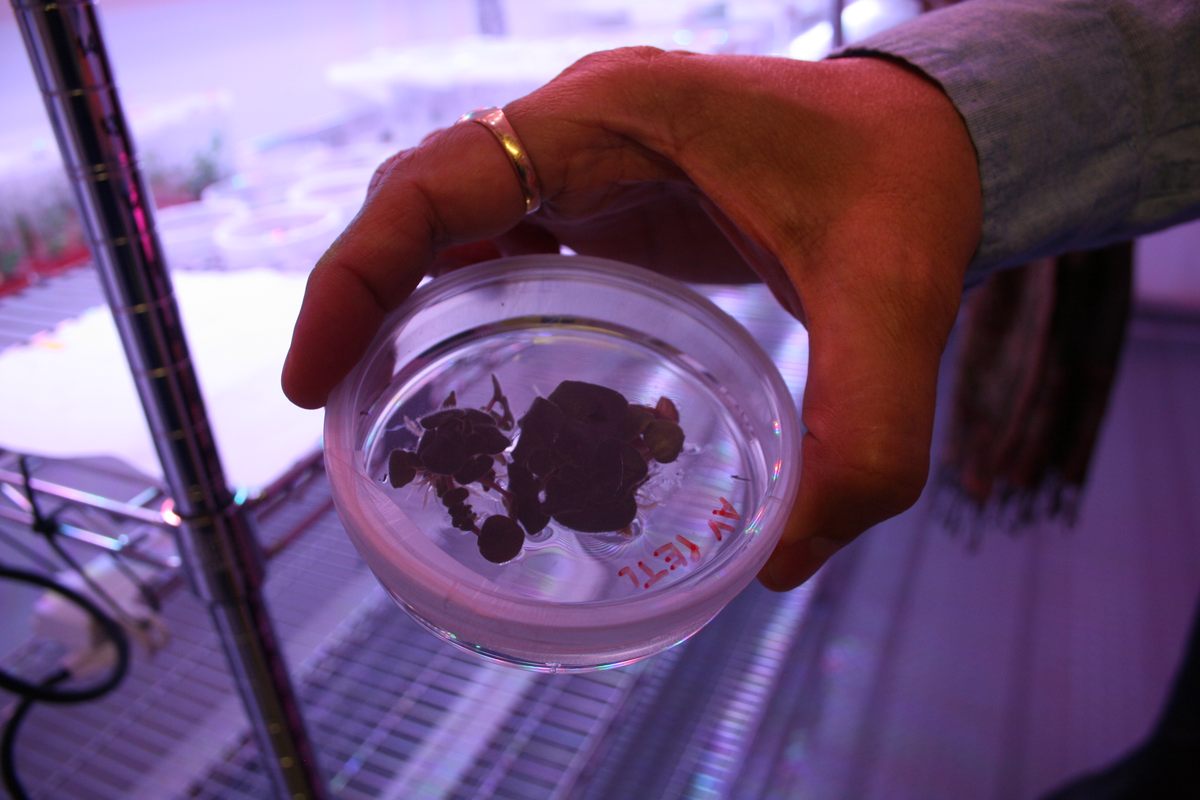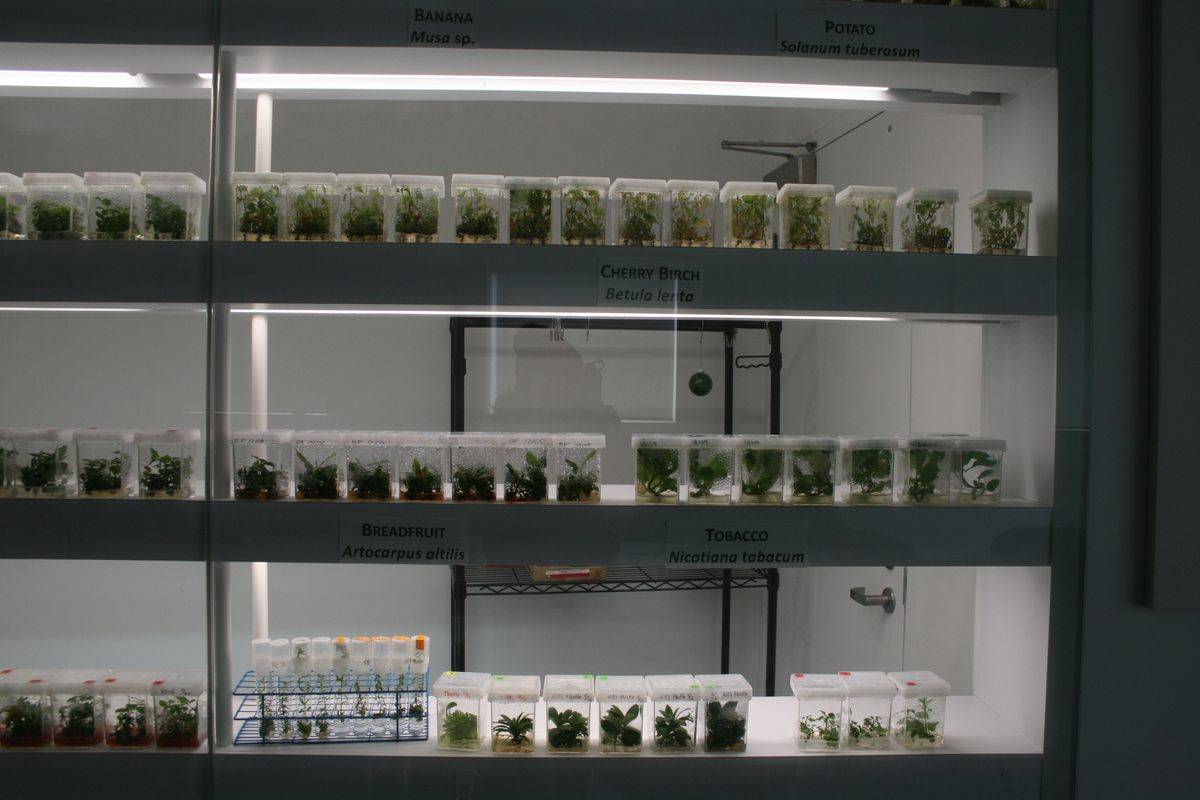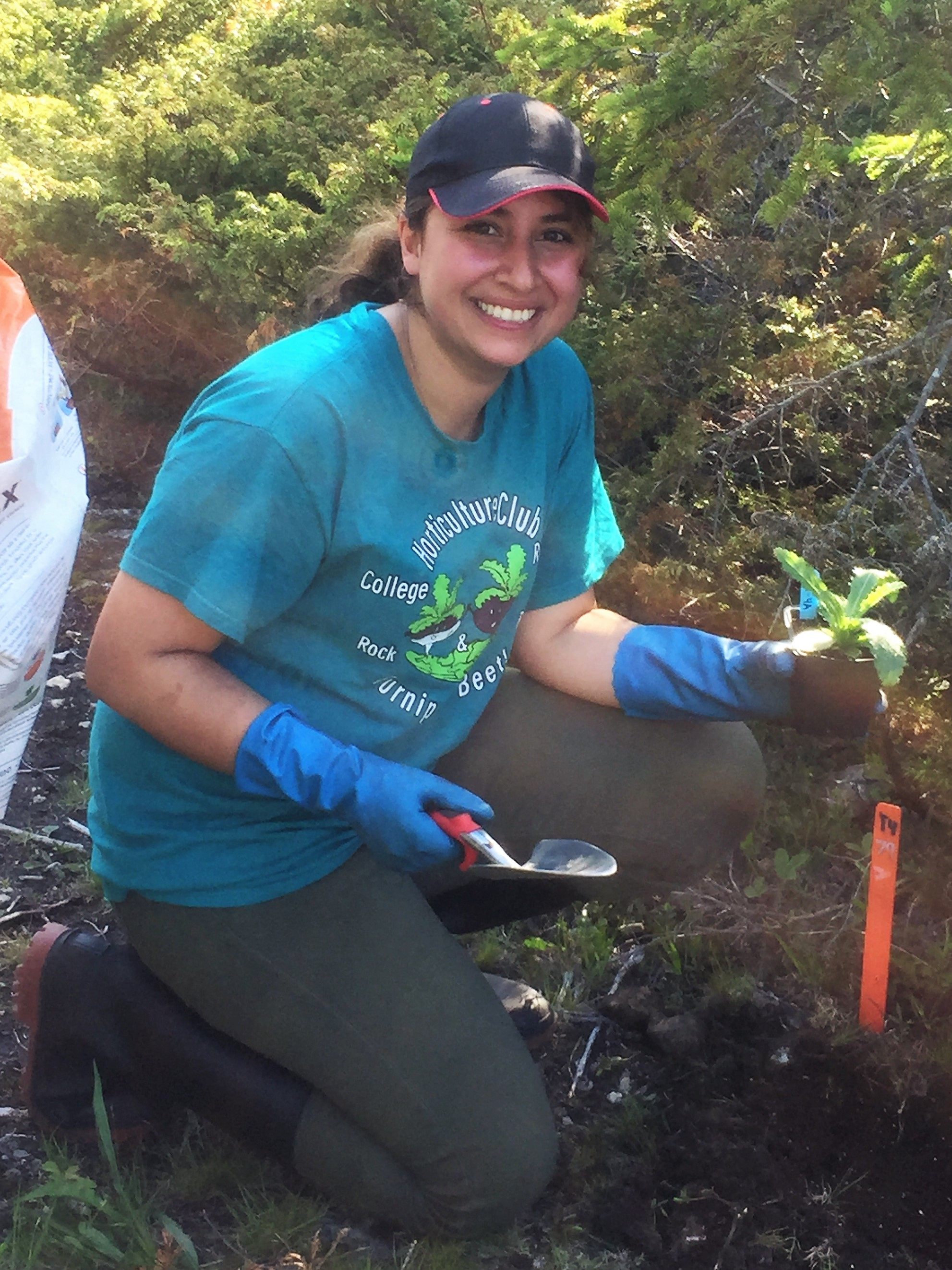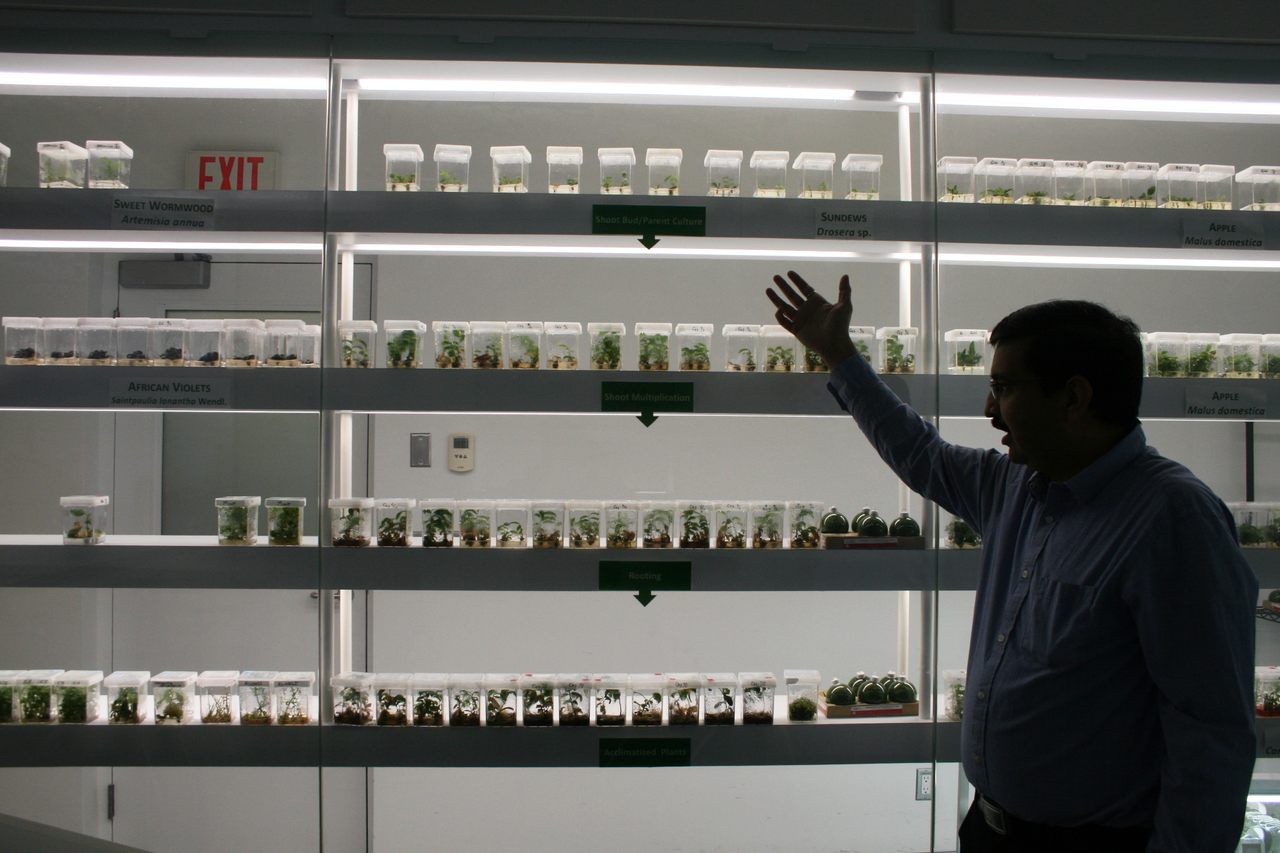One of 2017’s Most Exciting Plant Conservation Moments
In Ontario this year, researchers propagated a rare species and released it back into the wild.
Just outside the village of Tobermory, Ontario, in a protected area called Bruce Peninsula National Park, there lives a small population of a tiny plant called the Hill’s Thistle. Some are growing in sandy soil. Some are on rocky outcroppings. All are scattered along the west side of Bruce Peninsula—a 20-mile-wide jut of land that separates Lake Huron from the Georgian Bay—and on nearby Manitoulin Island.
For the first few years of its life, the Hill’s Thistle is a broad rosette of spiky leaves. After that, if things go well, it will suddenly shoot up two feet tall and make a few small purple flowers. In other words, it’s a pretty ordinary thistle. But the Bruce Peninsula population is special. About 300 of the plants living in this location started their lives in a carefully controlled research lab.
Instead of sprouting from seeds, they were grown from small pieces of plant tissue, and spent their early days bathing in specially concocted nutrient mediums and basking in curated LED light. This past summer, they were planted in 12 different sites on and around the Peninsula. If the researchers that hand-reared them get what they’re hoping for, their reintroduction to the wild may pave the way for similar projects across Canada.

Before these Hill’s Thistles tried their luck in the park, they were living about three hours south, on the first floor of a squared-off laboratory building. That’s the home of the Gosling Research Institute for Plant Preservation, or GRIPP, a program based out of the Department of Plant Agriculture at the University of Guelph, and overseen by Professor Praveen Saxena.
When I visited the Institute this past fall, I was greeted by two research associates, Dr. Mukund Shukla and Dr. Christina Turi. The lab’s classroom was flanked with what resembled a cluster of botanical high-rises: vessel after vessel filled with small clones, of all different species and at all different stages of growth, stacked on vertical shelves. One wall held whole neighborhoods of tobacco and apple trees. In another corner, dozens of baby hazelnut trees tilted back and forth on specially programmed racks.
GRIPP’s work is built around a technique called micropropagation. In use since the late 1950s, this method takes advantage of plants’ regenerative capabilities to grow entire individuals from a small amount of tissue. Under the right conditions, a tiny slice of root or bud produces leaves, shoots, and everything else that makes a plant.

Because micropropagation creates identical plants—and because it happens indoors, and so is not tied to seasonal growth cycles—it’s popular with companies trying to streamline the plant production process, especially those who grow food or houseplants. But as Saxena later explained to me over the phone, “applying it to endangered species is relatively new.” Other groups that currently use the technique include the University of Hawai’i at Manoa’s Hawaiian Rare Plant Program, which preserves and distributes endangered island plants, and the Atlanta Botanical Garden, which is growing and replanting native orchids in Georgia.
While the lab has some more industrial projects in the works—there is talk, for example, about growing uniformly sized apples and hazelnuts—most of the lab’s focus is on rare plants, as well as those with medicinal, spiritual, or cultural importance. After I finished my tour of the plant city, Shukla fills me in on how GRIPP got started.
The Institute, he explains, grew out of a conversation between Saxena, who has spent his career studying how plants grow, develop, and adapt to changing environments, and Dr. Philip Gosling, the philanthropist behind the conservation-oriented Gosling Foundation. “Philip asked, ‘Why is no one working to save the American Elm?’ And Praveen said, ‘We don’t have the funds to undertake such projects!’” Shukla recalls. “The next day, Dr. Gosling made a significant donation to allow us to start this research immediately.”

Enabled by this funding, Saxena’s team began experimenting with micropropagation of the American Elm, using buds from the only tree on the university’s campus that had survived the ravages of Dutch Elm disease. Success with this led to the official formation of GRIPP in 2012. Since then, researchers have applied the same tactics to various other rare species, culminating—so far—in this past summer’s reintroduction of the Hill’s Thistle.
Micropropagation, the researchers keep telling me, is “like photocopying”: take one plant, and get an innumerable amount of identical copies. While this is an appealing analogy, it also elides the huge amount of work involved. You can’t just put a plant in a Xerox machine, press a button, and get a whole field’s worth. Instead you have to follow a careful series of steps: obtaining an original, pampering each propagated plant, and then toughening it up, so that it’s ready to get back out there.
That first step—getting existing tissue to make copies of—is easier said than done, especially when it comes to endangered plants. Government organizations with jurisdiction over rare species won’t just give bits of them away willy-nilly. For the Hill’s Thistle experiment, it took more than a year to get permission from Parks Canada to work at Bruce Peninsula, and to complete the appropriate permits, says Saxena. (The park is happy with the results.)

Plus, many endangered plants got that way, at least in part, because they have low reproduction rates. Out of the 29 Hill’s Thistle seeds that Saxena’s lab managed to obtain, “only two germinated,” he says. To perform a statistically analyzable experiment, scientists normally need at least 20. “But with the endangered plants, whatever we can get—even if it’s just one—we’re happy to work with,” Saxena says. The flexibility of tissue-based micropropagation can also be a boon for plants that don’t tend to make a lot of viable seeds, or simply take a long time to produce them, like trees.
Once you’ve got your tissue bits in hand, growing them into entire new plants involves a lot of finesse. Plants can be finicky, the researchers explain to me, and different ones have different growth requirements. If the researchers want their specimens to thrive, they need to figure out exactly what those requirements are. While these specifications—known as protocols—are available for a lot of crop plants and ornamentals, no one has bothered figuring them out for most endangered species, which often need completely different things in order to thrive.
This happens to be Shukla’s specialty. When it’s time to develop a protocol for a new species, he spends as long as it takes to figure out what will allow that plant to thrive in the laboratory. He finds the best combination of light color and intensity—brighter for overgrowth plants, for example, and shadier for undergrowth ones. He concocts different types of growth mediums, mixing various nutrients, vitamins, and hormones like a bartender with a fickle customer. “Mukund is the plant whisperer,” says Turi. “The plants come in, and he talks to them. They tell him their grievances. And he says, ‘Ok, I’ll help you.’”

The fruits of his labor line the office walls, in hundreds of clear plastic vessels, all optimized for the particular species living inside. Each sloshes with a personalized cocktail: extra iron for the hazelnuts, root-inhibiting hormone for the elms. Each is accompanied by an individual LED strip, which can be tweaked according to the plant’s preferences. (Full-spectrum LEDS, which approximate sunshine, glow over each row.) Some are even kept on mechanical racks that tilt the containers back and forth, mixing the nutrients in the medium while aerating the roots, and making sure to keep plant neighbors from poisoning each other with defensive root chemicals. Gazing at it is like watching babies being gently rocked to sleep.
Once they’ve grown big enough, the plants’ fates diverge. Some, like those two summer batches of Hill’s Thistles, are sent to try their luck in the wild. The second group is instead saved for the future. Those plants are sliced into more tissue samples, dried out, placed into labeled test tubes, and brought to the room next to the office. There, they are placed in a cylinder about the size of a municipal trash can, where they are literally frozen in time.
Cryopreservation is a vital part of GRIPP’s mission, explains Shukla. Because so little tissue is required for micropropagation, it’s possible to store an enormous number of species in a very small space. “Sixteen thousand samples will fit in this freezer,” explains Shukla. “Technically, there is enough space for every species in the country to fit into two containers.” (In practice, multiple samples of each species are stored, to ensure both redundancy and genetic diversity.) He briefly removes the lid, and the machine exhales a cloudy breath of liquid nitrogen.

The cryo-freezer is essentially a plant ark, there for insurance against future disasters. If, hypothetically, a tornado hit the Bruce Peninsula and tore up every single Hill’s Thistle, cryopreserved tissue could help get the population going again after the rest of the landscape had healed. “You still have a source to go back to,” says Saxena. “You can replant and propagate and replant.”
While freezing tissue lacks the flexibility of other storage schemes—if you save seeds, for example, you can just plant them in the ground, no personalized plant condos required—it does have longevity going for it. “It’s not feasible to preserve most seeds for a long time without losing viability,” says Shukla. “But if you freeze the tissue, it may last forever.” In 2012, scientists in Russia successfully regenerated a plant from a fruit that had been frozen underground since the late Pleistocene, roughly 30,000 years ago; in that case, the storage scheme was not a freezer, but a squirrel burrow.
Those plants that are slated for replanting are also destined for a big life change. While coddling is all well and good for a while, if micropropagated plants want to make it in the big bad world, they have to learn a few lessons first. A sheltered seedling will be blindsided by things more rough-and-tumble plants are used to, such as bugs, inclement weather, and competing species. It might not even bother to build important defenses, like the waxy cuticle that protects its leaves from drying out. The researchers compare it to the case of a whale that has spent its whole life in a tank at Sea World: you can’t just throw it into the ocean.

And so, once they’ve gotten big enough, the micropropagated plants get their first taste of the real world, moving from their childhood homes to the botanical equivalent of a college dorm. In the Hill Thistle’s case, that means the university greenhouse. As Turi and Shukla walk me inside, we pass an empty box trap, a reminder of the risks posed by this new environment. “Gophers,” explains Shukla.
When we reach the thistles, the varying effects of this tough love are readily apparent. While many of the plants are spry and spiky, some are dry and brown. They didn’t make it past training, and have selected themselves out. Those that remain—and that last until this coming summer—will join their cousins at Bruce Peninsula.
Meanwhile, other seedlings currently in the lab are waiting for their turn in the (genuine) sunshine. “Now that the Hill’s Thistle is a success story, we hope that there will be many more,” says Saxena. The researchers have a few other reintroduction projects in the works, including one that would bring a different thistle, the Mingan Thistle, to the Mingan Archipelago National Park Reserve, in Quebec.

Of course, even if it does catch on, micropropagation is just one piece of the overall puzzle of conservation. It doesn’t much matter how quickly you can produce plants in a lab if there’s nowhere for them to grow. “More often than not, conservation is a very attractive issue to talk about,” says Saxena. In practice, though, people are less willing to make the choices necessary for it to occur, unless they have a particular passion for plants, or some personal stake.
The Hill’s Thistle, for example, is a vital part of its ecosystem. It feeds local birds, deer, pollinators, and may help to stabilize the soil for nearby plants. But it wasn’t chosen exclusively for these reasons. It also had one of the proverbial friends in high places: Philip Gosling, whose foundation funds GRIPP, was one of the original founders of the Bruce Trail, the major hiking trail that cuts through Bruce Peninsula National Park.
At the end of my visit, Turi tells me about the test-tube free ways GRIPP is trying to address this issue. These include putting on public workshops, hosting field trips for schoolkids, and putting out a magazine called Spiritual Botany, which is focused on human-plant relationships. “You can do as much tissue culture as you want,” Turi says, “but you have to also foster a cultural awareness. We need to talk about why the plants are important.” Otherwise, this small bit of advancement will never bloom into full-fledged change.
















Follow us on Twitter to get the latest on the world's hidden wonders.
Like us on Facebook to get the latest on the world's hidden wonders.
Follow us on Twitter Like us on Facebook